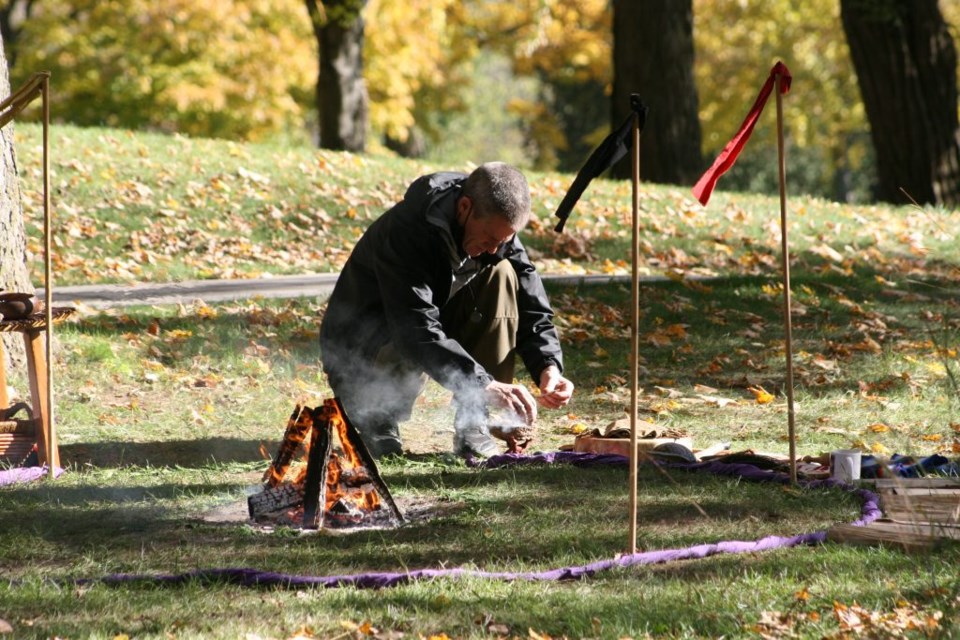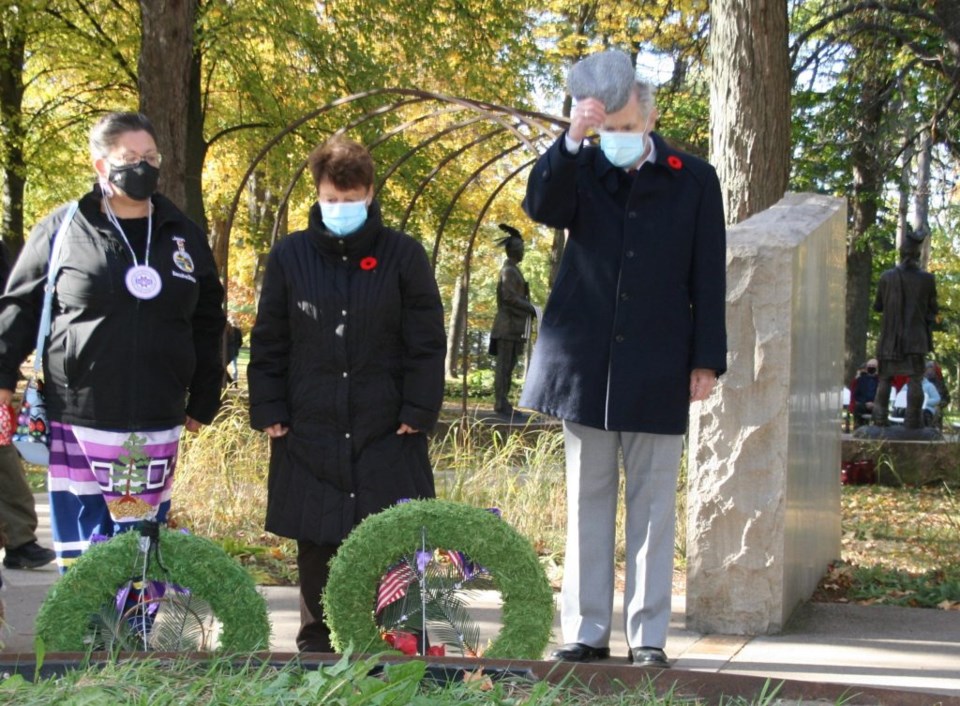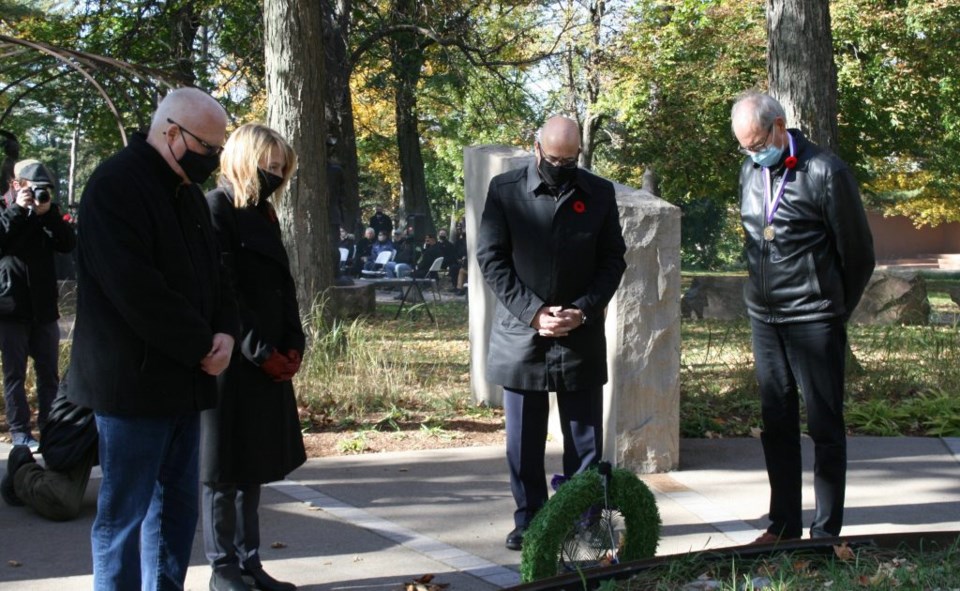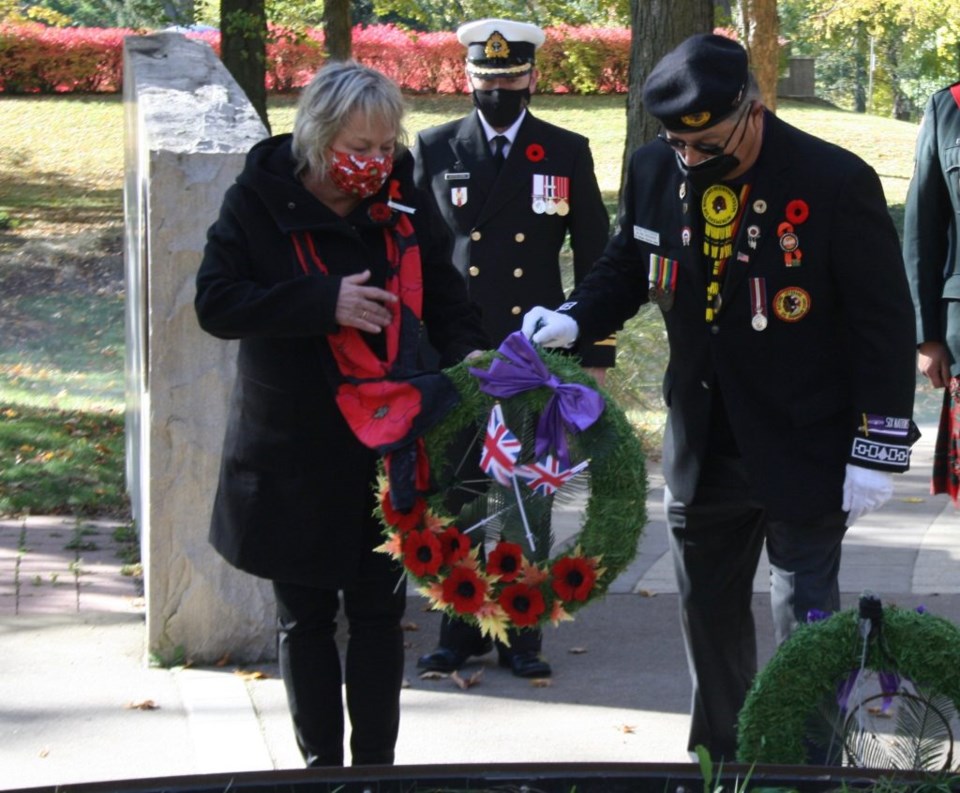
The boom of a single cannon blast echoed through the Queenston Heights sky Saturday afternoon, paying tribute to the many Indigenous veterans who fought for the country over more than 200 years.
Dignitaries, family members and representatives from the Indigenous community gathered at the Landscape of Nations Memorial, the site of the Battle of Queenston Heights, where Six Nations and Native Allies fought alongside their British and Canadian compatriots during the War of 1812.
Before the watchful eyes of the statues of John Norton and John Brant, Tim Johnson, director of the Landscape of Nations 360° Indigenous Education Initiative, pointed out the consecrated nature of the ground on which he was standing.
“It is the site of the Battle of Queenston Heights,” he confirmed. “There’s a dialogue here now, between the Brock Monument and the Landscape of Nations Memorial. We are now able to tell the full story of this history, an important formative era that had significant Indigenous contributions.”
That battle, on Oct. 13, 1812, marked a major turning point in the emergence of a young country whose borders and character were being tested by the Americans. Six Nations and Native Allies helped the British in victorious efforts in pivotal events at Queenston Heights and throughout the War of 1812.
Following the war, a historic entreaty of peace and reconciliation was made at Niagara on Aug. 31 and Sept. 1, 1815, between the Haudenosaunee of the Grand River and those of New York who had allied with the Americans.
This year marks the third Niagara Parks Valour and Victory Ceremony to honour Indigenous veterans at the memorial site. As Johnson pointed out, Indigenous contributions to Canada’s war efforts did not start or end with the War of 1812, but for many years those contributions were not recognized.
“Strong alliances had been established over generations, even before the War of 1812, between the Crown and various Indigenous nations,” Johnson told The Local. “Indigenous nations took these alliances very seriously. That cooperation continued throughout the years, but after that war it was deemed that Native peoples were no longer needed or necessary, so the policies began to shift.”
Johnson says the notion of wardship replaced the alliances, as the country’s government took control over the lives of Indigenous peoples. Residential schools and treaty violations were results of that wardship. He called the yearly memorial service a launching pad not only for remembering how much Native people contributed 209 years ago, but also for understanding what happened after that period.
Johnson was followed by a man recognizable to many local residents. Ron Dale was Parks Canada’s project manager for the War of 1812 Bicentennial. Speaking without notes, the now-retired Dale outlined the contributions of Six Nations members to both World Wars, as well as the Boer War, Korean War and the mission in Afghanistan.
Sgt. Ray Starks, a member of the M’Chigeeng First Nation on Manitoulin Island, was the guest speaker. Starks joined the armed forces in 1993 as a reservist with the Essex and Kent Scottish Regiment near Chatham. His current role is in diversity recruiting for the forces.
“My father was a paratrooper with the Princess Patricia’s, so I heard his stories” he said. “I also fortunately had an excellent history teacher who knew I was First Nations and took it upon himself to add that to our lessons about wars.”
As the only Indigenous student in his class, Starks valued his teacher for the lessons he and his classmates learned about the sacrifices made by Canada’s Native population.
“For so long these sacrifices were never honoured,” Starks continued, pointing out that the focus for many years was on conflicts from the 20th century. “They usually don’t go far back enough to when the country was fighting for its very existence. If it wasn’t for the British and Indigenous forces that were here, we wouldn’t be waving the Canadian flag now.”
Of more recent Indigenous veterans, Starks said, “the sacrifices they made are the same sacrifices that were made here on this battlefield. To be able to talk to those veterans and carry on their stories, to pass them on to our children, is huge.”
Michele-Elise Burnett, a Métis with Algonquin roots, presented medals to three Indigenous veterans. Karl Dockstader of the Niagara Regional Native Centre and Jennifer Dockstader of the Fort Erie Native Friendship Centre accepted on behalf of their family member, Tom Dockstader, an Oneida Nation veteran who served in Vietnam. Also receiving medals were two Tuscarora Nation members: Vietnam veteran Bruce Patterson, and Darrell Doxtdator, a former army medic.
As Fred Bowering kept the sacred fire alive just metres away, participants in the program, along with Niagara Falls MP Tony Baldinelli, St. Catharines MPP Jennie Stevens and Niagara-on-the-Lake Lord Mayor Betty Disero, laid memorial wreaths at the battle site’s Memory Circle.
Johnson told the gathered crowd that all Canadians are morally obligated to acknowledge the legacy of those who preceded them. And that the Landscape of Nations Memorial is the perfect place to do that every year.
“When you encounter this exhibition,” Johnson said, “from the entrance experience, following the Wampum Trail, gently sloping up and curving to the Memory Circle and then back down, it has a feeling to it. There’s an aesthetic that’s been created for it. When people come up here they say they feel something. It’s an experience.”


